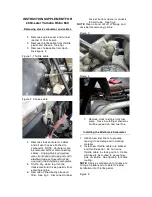
Driv
ing precautions
126
Driving precautions
Running in
Moving parts need a certain time to achieve
maximum operating efficiency as a unit. Please
comply with the following instructions, which
are intended to ensure that your car achieves its
optimum operating life and economy.
Engine and final drive
Observe the national speed limits in the country
in which you are travelling.
Up to 2000 km, approx. 1200 miles
Drive at varying road and engine speeds, but do
not exceed the following values:
>
Petrol engine
4500 rpm, or 160 km/h, approx. 100 mph
>
Diesel engine
3500 rpm, or 150 km/h, approx. 90 mph
Avoid full throttle and do not use the automatic
transmission kick-down.
From 2000 km, approx. 1200 miles,
onwards
Engine and road speeds can be gradually
increased.
Tyres
New tyres do not achieve their full road
grip immediately, for production reasons. You
should therefore drive in a restrained manner
for the first 300 km, approx. 200 miles.
Brake system
Brake pads and discs do not achieve a favoura-
ble wear and contact pattern until the car has
covered about 500 km, approx. 300 miles. Drive
with caution during this running in period.
After fitting new parts
The same running in procedures should be
observed if any of the components mentioned
above have to be renewed in the course of the
car's operating life.
General driving hints
Closing the tailgate
Drive only with the tailgate fully closed,
otherwise exhaust gases could enter the
passenger compartment.
<
If it is nevertheless necessary to travel with the
tailgate open, observe the following precau-
tions:
1.
Close all windows and the panorama glass
roof.
2.
Increase the air volume from the automatic
air conditioning considerably, see
pages
Hot exhaust system
High temperatures occur in the exhaust
system of all vehicles. Never remove the
head shields protecting this area, nor apply
underseal to them. Make sure that when the car
is driven or parked and when the engine is
idling, no easily flammable material such as hay,
leaves, grass, etc. comes into contact with the
hot exhaust pipe. It could ignite and cause a fire,
with the risk of severe injuries or damage. Do
not touch hot exhaust tail pipes; otherwise
there is a risk of burns.
<
Diesel particle filter*
The diesel particle filter collects soot particles
and burns them periodically at high tempera-
tures. This cleaning procedure takes several
minutes. Under some circumstances, you may
notice it by the fact that the engine temporarily
runs more roughly and requires a higher engine
speed for normal power development. In addi-
tion, the exhaust may cause some noise and
emit a small amount of smoke, even after the
engine has been switched off.
Online Edition for Part-No. 01 41 0 013 209 - © 04/07 BMW AG
Summary of Contents for 2007 X5 3.0d
Page 2: ...Online Edition for Part No 01 41 0 013 209 04 07 BMW AG ...
Page 8: ...Online Edition for Part No 01 41 0 013 209 04 07 BMW AG ...
Page 26: ...Online Edition for Part No 01 41 0 013 209 04 07 BMW AG ...
Page 126: ...Online Edition for Part No 01 41 0 013 209 04 07 BMW AG ...
Page 136: ...Online Edition for Part No 01 41 0 013 209 04 07 BMW AG ...
Page 164: ...Online Edition for Part No 01 41 0 013 209 04 07 BMW AG ...
Page 214: ...Online Edition for Part No 01 41 0 013 209 04 07 BMW AG ...
Page 240: ...Online Edition for Part No 01 41 0 013 209 04 07 BMW AG ...
Page 270: ...Online Edition for Part No 01 41 0 013 209 04 07 BMW AG ...
Page 271: ...Online Edition for Part No 01 41 0 013 209 04 07 BMW AG ...
Page 273: ...X5 En Online Edition for Part No 01 41 0 013 209 04 07 BMW AG ...
















































